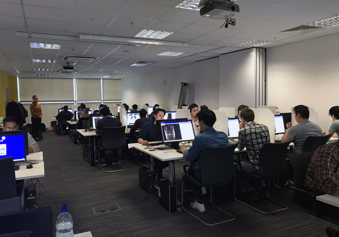DDMFR Part B - purpose of assessment statement
The various components of the Diploma of Dental & Maxillofacial Radiology (DDMFR) of the Royal College of Radiologists (FRCR) examinations have been designed to assess the knowledge and skills of dental and maxillofacial radiology trainees as they progress through a number of levels of competence and to demonstrate readiness to progress to the next stage of training.
The award of the DDMFR indicates that the candidate has attained the required level of competence across the components of the DDMFR curriculum. The DDMFR Part B is not designed as an exit examination, but instead marks an important step in the progression of trainees towards the ability to use their knowledge and skills as independent practitioners. At the same time the examination provides the public with assurance that dental and maxillofacial radiologists in training are being assessed to a consistently high standard and that the holders of the Diploma have obtained a nationally recognised qualification.
The Part B DDMFR Examination has three components: a rapid reporting component, a long case reporting component and an oral component. The three parts of the examination assess different aspects of a candidate’s radiological skills, all of which are considered necessary for safe and effective radiological practice.
Rapid Reporting Component
The rapid reporting component is built on the fact that there is high volume throughput of dental radiographs in a Dental Hospital, and assessing such films forms a large part of a radiologists’ workload. It tests the ability of the candidate to swiftly decide if an image is normal or abnormal and to provide a diagnosis for the abnormality. Images are primarily plain radiographs. Radiographs assessed include normal anatomy including normal variants and disease that would be within the competence of a dental and maxillofacial radiologist to report. It includes findings that a dentist might refer for a second opinion. They should represent a typical session of routine dental reporting in the workplace. Each abnormal radiograph shows one significant diagnosable abnormality.
This element of the examination seeks to reflect and reproduce a typical radiographic reporting session. The competent radiologist must be able to identify abnormalities when present and confidently exclude them when they are not.
Long Case Reporting Component
The long case reporting component recognises that radiologists largely communicate their findings in the form of written reports. This element tests the ability of the candidate to make a number of observations, determine the relevance of these findings, deduce a list of differential diagnoses, suggest the most likely diagnosis and discuss further management including additional imaging where appropriate. This part of the examination mirrors a mixed list of cross-sectional cases and sialography. Plain radiographs, isotope imaging and ultrasound images can also be included. A short, structured reporting sheet is provided. Cases often involve more than one imaging modality performed on the same patient e.g., plain radiograph, CT and isotope study.
This element of the examination aims to test the candidate’s ability to assess and correctly interpret a variety of clinical cases, and to accurately communicate their findings, conclusions and recommendations.
Oral Component
The oral component further assesses the candidate’s powers of observation and interpretation, and in addition allows assessment of the candidate’s ability to discuss wide-ranging aspects of patient care as influenced by the radiological findings.
Candidates are expected to be able to integrate their observations with emerging clinical information to help refine their differential diagnosis. It also tests their ability to communicate effectively, their analytical and decision-making skills and allows the candidate to demonstrate depth of knowledge and ensure that their practice supports patient safety. This element of the examination mirrors day-to-day clinical discussions and MDT meetings, which form an integral part of a radiologist’s workload. Oral examinations allow examiners the unique opportunity to explore the candidates’ depth of knowledge and to test higher cognitive skills. The format allows for flexibility and complexity to be built into the examiners’ questioning.
Our exams
Find out more about our FRCR exams in clinical radiology and clinical oncology, and DDMFR exams in dental and maxillofacial radiology.
